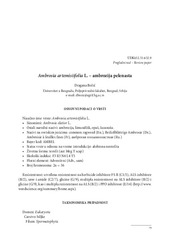Приказ основних података о документу
Ambrosia artemisiifolia L.: Common ragweed
Ambrosia artemisiifolia L. - ambrozija pelenasta
| dc.creator | Božić, Dragana | |
| dc.date.accessioned | 2020-12-17T22:27:12Z | |
| dc.date.available | 2020-12-17T22:27:12Z | |
| dc.date.issued | 2018 | |
| dc.identifier.issn | 0354-4311 | |
| dc.identifier.uri | http://aspace.agrif.bg.ac.rs/handle/123456789/4883 | |
| dc.description.abstract | A. artemisiifolia is a cosmopolitan species, widely distributed across all continents. Its biological and ecological properties, as well as the soil and climate characteristics in Serbia, have enabled its dramatic spread in our country, where it has obtained the status of an invasive alien neotophyte species. Due to its high germination rate, fast initial growth and photosynthetic activity and allelopathic effect on neighbouring species, common ragweed is a highly competitive species with a strong spread potential. It is an important weed in row crops, orchards and vineyards, fields where medicinal herbs and alfaalfa are grown, in cereals and fallow fields. It also often grows along the roads, in urban settlements, ruderal habitats and on pastures. It is especially problematic in sunflower fields, where the possibilities of its chemical weed control are very limited due to the relatedness of this species and the crop. In addition to yield losses, it also has a negative effect on the quality of the final agricultural products. Because it is considered a quarantine pest in some countries, it can be a limiting factor for the export of agricultural produce. The pollen of common ragweed, which is a strong allergen, causes serious health issues in humans and animals. The approach in the control of common ragweed differs depending on its presence in agricultural or non-agricultural land. In agricultural land, the aim is to reduce the populations of common ragweed below the threshold where it has negative impacts on the crop, while in non-agricultural land the aim is to conduct its control prior to the flowering period, in order to prevent pollen production and reduce the problems with allergic reactions in the general population. It is necessary to conduct continuous mechanical, physical and chemical control of common ragweed in non-agricultural land, while in crops it is recommended to perform crop rotation, mowing, sowing of clover grass mixtures, apply well-aged manure and employ intensive crop treatment and herbicide application measures. In addition to preventive and direct control measures, which are normally employed in weed control practices, a long-term solution for common ragweed problem would be to also include various administrative measures. | en |
| dc.publisher | Herbološko društvo Srbije | |
| dc.relation | info:eu-repo/grantAgreement/MESTD/Integrated and Interdisciplinary Research (IIR or III)/46008/RS// | |
| dc.rights | openAccess | |
| dc.source | Acta herbologica | |
| dc.subject | ambrosia artemisiifolia | en |
| dc.subject | biology | en |
| dc.subject | competition | en |
| dc.subject | harmful | en |
| dc.subject | control | en |
| dc.title | Ambrosia artemisiifolia L.: Common ragweed | en |
| dc.title | Ambrosia artemisiifolia L. - ambrozija pelenasta | sr |
| dc.type | article | |
| dc.rights.license | ARR | |
| dc.citation.epage | 95 | |
| dc.citation.issue | 2 | |
| dc.citation.other | 27(2): 79-95 | |
| dc.citation.rank | M52 | |
| dc.citation.spage | 79 | |
| dc.citation.volume | 27 | |
| dc.identifier.doi | 10.5937/ActaHerb1802079B | |
| dc.identifier.fulltext | http://aspace.agrif.bg.ac.rs/bitstream/id/3395/4880.pdf | |
| dc.type.version | publishedVersion |


